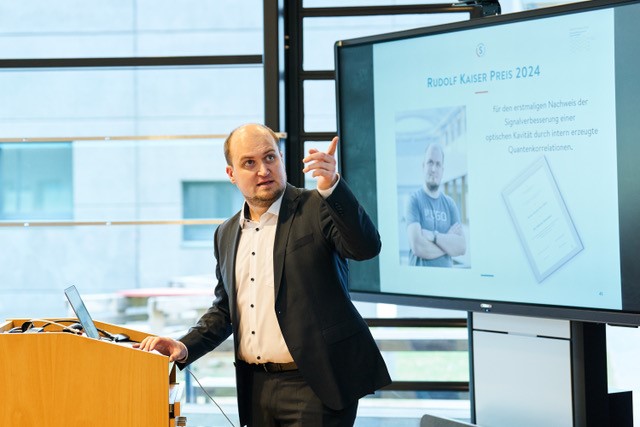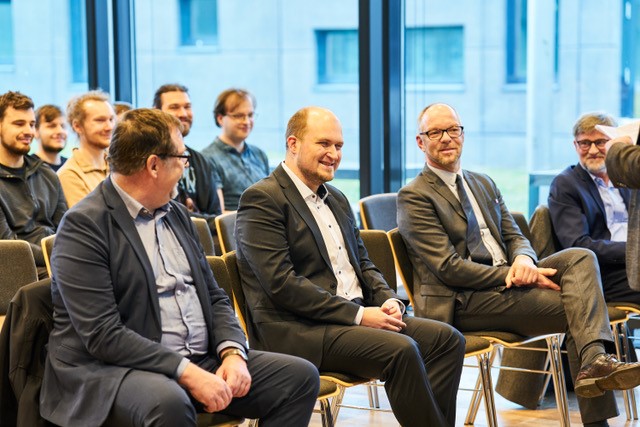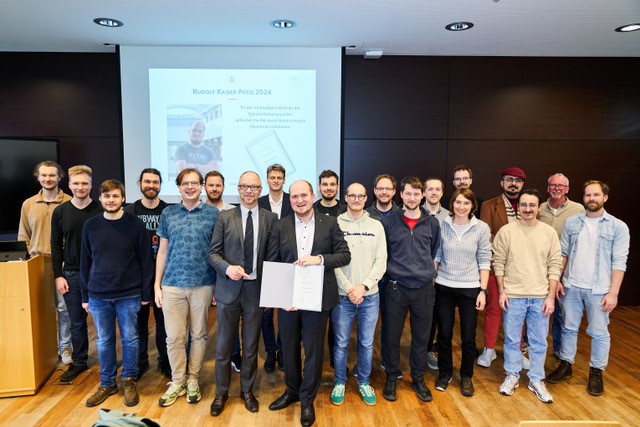Quantum Physics
Mikhail Korobko awarded the Rudolf-Kaiser-Prize 2024
14 March 2025

Prof. Dr. Markus Drescher (Head of Physics Department), Prof. Dr. Roman Schnabel (Group leader Nonlinear Quantum Optics, where Mikhail Korobko works), award winner Dr. Mikhail Korobko, Mr. Rainer Lüdtke (German Foundation Center), and Prof. Dr.-Ing. Norbert Ritter (Dean of the MIN Faculty). Photo: Claudia Höhne
Dr. Mikhail Korobko awarded the Rudolf-Kaiser-Prize 2024
Dr. Mikhail Korobko from the Institute of Quantum Physics in the Department of Physics at Universität Hamburg has been awarded the 2024 Rudolf Kaiser Prize “for the first experimental demonstration of signal enhancement in an optical cavity through internally generated quantum correlations.” The prize, worth €30,000, is awarded to experimental physicists who have published several outstanding research papers but have not yet been appointed to a professorship.
The award honors Dr. Korobko’s pioneering work on a new class of optomechanical force measurements, which go beyond quantum-enhanced gravitational wave detection.
When the acceleration of a mass changes, so does its gravitational influence on the surroundings. This change propagates at the speed of light in all directions as gravitational waves. These waves are detected using extremely sensitive instruments that employ laser light injected and stored in optical cavities. Until now, there existed a trade-off between the best achievable sensitivity in such detectors and their bandwidth of observable signal frequencies. The ‘sensitivity-bandwidth product’ represented an upper limit that could not be surpassed.
Together with his co-authors, Dr. Korobko was the first to experimentally surpass this supposed limit. By imprinting quantum correlations onto the light within the cavity, they created what is known as “internally squeezed” quantum uncertainty. This led to a significant improvement in the sensitivity-bandwidth product—by up to 36% compared to the classical case. These findings were published in the journal Physical Review Letters:
https://journals.aps.org/prl/abstract/10.1103/PhysRevLett.118.143601
In follow-up publications, he explored further applications of this technology in precision sensing, such as detecting changes in magnetic fields or searching for dark matter:
„Quantum expander for gravitational-wave observatories“, https://www.nature.com/articles/s41377-019-0230-2
„Mitigating Quantum Decoherence in Force Sensors by Internal Squeezing“ https://journals.aps.org/prl/abstract/10.1103/PhysRevLett.131.143603
„Fundamental sensitivity limit of lossy cavity-enhanced interferometers with external and internal squeezing“ https://journals.aps.org/pra/abstract/10.1103/PhysRevA.108.063705
The prize jury praised Dr. Korobko as “an unusually versatile young scientist who, after focusing on theory during his physics studies, has taken on highly challenging experimental questions and their implementation.”
About the Prize and the Foundation
The Rudolf Kaiser Prize has been awarded annually since 1989 to experimental physicists who have published multiple excellent research papers but have not yet been appointed to a professorship. The prize is endowed with €30,000. According to the founder’s intent, special recognition is given to outstanding work that was not carried out using large-scale research facilities or massive machinery.
The Rudolf Kaiser Foundation was established in 1987 by Dr. Rudolf Kaiser. Born in 1923 in Nuremberg, he served for many years as presiding judge at the German Federal Patent Court and earned his postdoctoral qualification (Habilitation) in experimental physics in 1979 at the Technical University of Munich, where he focused particularly on supporting young scientists.
About the Prize Winner
Mikhail Korobko completed his physics degree in 2013 at Lomonosov Moscow State University. During his studies, he conducted research twice at the California Institute of Technology in the U.S. After graduating, he moved first to Leibniz University Hannover and later to Universität Hamburg, where he earned his doctorate in 2020. Since 2022, he has held a permanent research position there and oversees research activities in ten laser laboratories. He has been, and continues to be, closely involved in the work of the LIGO collaboration, which in 2015 made the first direct detection of gravitational waves.
Further information can be find here.

Poto: Claudia Höhne

Poto: Claudia Höhne

Poto: Claudia Höhne
